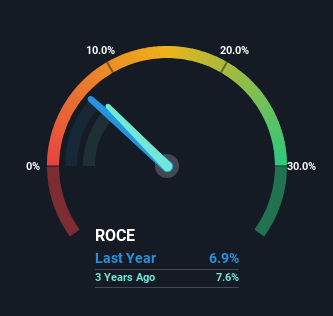Stock Analysis
- France
- /
- Telecom Services and Carriers
- /
- ENXTPA:ORA
Orange's (EPA:ORA) Returns Have Hit A Wall

What are the early trends we should look for to identify a stock that could multiply in value over the long term? Firstly, we'll want to see a proven return on capital employed (ROCE) that is increasing, and secondly, an expanding base of capital employed. Basically this means that a company has profitable initiatives that it can continue to reinvest in, which is a trait of a compounding machine. Although, when we looked at Orange (EPA:ORA), it didn't seem to tick all of these boxes.
What Is Return On Capital Employed (ROCE)?
For those who don't know, ROCE is a measure of a company's yearly pre-tax profit (its return), relative to the capital employed in the business. The formula for this calculation on Orange is:
Return on Capital Employed = Earnings Before Interest and Tax (EBIT) ÷ (Total Assets - Current Liabilities)
0.069 = €5.5b ÷ (€111b - €31b) (Based on the trailing twelve months to June 2023).
Thus, Orange has an ROCE of 6.9%. Ultimately, that's a low return and it under-performs the Telecom industry average of 9.1%.
See our latest analysis for Orange

Above you can see how the current ROCE for Orange compares to its prior returns on capital, but there's only so much you can tell from the past. If you'd like to see what analysts are forecasting going forward, you should check out our free report for Orange.
What Does the ROCE Trend For Orange Tell Us?
There are better returns on capital out there than what we're seeing at Orange. The company has employed 20% more capital in the last five years, and the returns on that capital have remained stable at 6.9%. Given the company has increased the amount of capital employed, it appears the investments that have been made simply don't provide a high return on capital.
In Conclusion...
In conclusion, Orange has been investing more capital into the business, but returns on that capital haven't increased. Unsurprisingly, the stock has only gained 6.4% over the last five years, which potentially indicates that investors are accounting for this going forward. As a result, if you're hunting for a multi-bagger, we think you'd have more luck elsewhere.
One more thing, we've spotted 4 warning signs facing Orange that you might find interesting.
While Orange may not currently earn the highest returns, we've compiled a list of companies that currently earn more than 25% return on equity. Check out this free list here.
Valuation is complex, but we're helping make it simple.
Find out whether Orange is potentially over or undervalued by checking out our comprehensive analysis, which includes fair value estimates, risks and warnings, dividends, insider transactions and financial health.
View the Free AnalysisHave feedback on this article? Concerned about the content? Get in touch with us directly. Alternatively, email editorial-team (at) simplywallst.com.
This article by Simply Wall St is general in nature. We provide commentary based on historical data and analyst forecasts only using an unbiased methodology and our articles are not intended to be financial advice. It does not constitute a recommendation to buy or sell any stock, and does not take account of your objectives, or your financial situation. We aim to bring you long-term focused analysis driven by fundamental data. Note that our analysis may not factor in the latest price-sensitive company announcements or qualitative material. Simply Wall St has no position in any stocks mentioned.
About ENXTPA:ORA
Orange
Orange S.A. provides various fixed telephony and mobile telecommunications, data transmission, and other value-added services to customers, businesses, and other telecommunications operators in France and internationally.
Undervalued established dividend payer.

